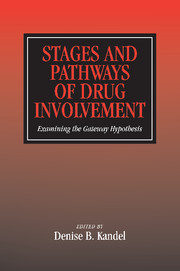Book contents
- Frontmatter
- Contents
- List of Contributors
- Foreword
- Preface
- Part I Overview
- Part II Recent Substantive Findings: What Do We Know About Stages of Drug Use, Risks, and Protective Factors?
- Part III Impact of Prevention Interventions: A Test of the Progression Hypothesis
- Part IV Methodological Issues and Approaches: Advantages and Limitations of Alternate Methods
- Part V Animal Models and Biological Processes: Implications for Drug Progression
- 13 The Value of Animal Models to Examine the Gateway Hypothesis
- 14 Sensitization as a Process Underlying the Progression of Drug Use via Gateway Drugs
- 15 Neurobiology of Drug Addiction
- Part VI Conclusion
- Index
15 - Neurobiology of Drug Addiction
Published online by Cambridge University Press: 25 July 2009
- Frontmatter
- Contents
- List of Contributors
- Foreword
- Preface
- Part I Overview
- Part II Recent Substantive Findings: What Do We Know About Stages of Drug Use, Risks, and Protective Factors?
- Part III Impact of Prevention Interventions: A Test of the Progression Hypothesis
- Part IV Methodological Issues and Approaches: Advantages and Limitations of Alternate Methods
- Part V Animal Models and Biological Processes: Implications for Drug Progression
- 13 The Value of Animal Models to Examine the Gateway Hypothesis
- 14 Sensitization as a Process Underlying the Progression of Drug Use via Gateway Drugs
- 15 Neurobiology of Drug Addiction
- Part VI Conclusion
- Index
Summary
Major advances in our understanding of the neurobiology of addiction have been made and have important implications for a biological component of a Gateway Hypothesis of drug addiction vulnerability. The present chapter explores the conceptual framework and animal models that guide neurobiological research in addiction and reviews these neurobiological mechanisms for different components of the addiction process. Neurobiological mechanisms for the positive reinforcing effects of drugs of abuse, the negative reinforcement associated with drug dependence, and the neurobiological substates of craving are discussed. The focus is on neurobiological elements common to all major drugs of abuse that inform the Gateway Hypothesis from a biological perspective. Activation of certain neurochemical systems contributing to the acute reinforcing effects of drugs of abuse and activation of brain stress systems during acute withdrawal, in a common brain circuitry, may be common neurobiological mechanisms that have implications for the Gateway Hypothesis of the development of drug addiction.
Drug Addiction and Animal Models
Drug addiction is a chronically relapsing disorder that can be defined as a compulsion to take a drug with loss of control over drug intake (Figure 15.1). Important challenges for neurobiological research are to understand not only how drug use proceeds to drug addiction but why some individuals have a vulnerability for the transition that occurs between controlled substance or drug use and the loss of control that defines addiction or substance dependence.
- Type
- Chapter
- Information
- Stages and Pathways of Drug InvolvementExamining the Gateway Hypothesis, pp. 337 - 362Publisher: Cambridge University PressPrint publication year: 2002
- 9
- Cited by



